|
|
|||||
| home > architetture | |||||
| F-U-R.
adaptiveARCHIVE |
|||||
| ANALOG
PERFORMANCE MODE |
|||||
SET-UP
STUDIES. A physical model performs based on its material properties
and the chosen material editing techniques. When external forces are
given to this set-up a formal outcome is computed by the material itself.
Chosen material editing techniques: slicing, bundling. The degree
of material editing increased gradually over the length of the material
chosen forces: bending, compressing. The set up gives a structural
and organizational simulation computed by material. Set-up studies. TOPOGRAPHIC STUDIES. Once a set up was fixed the analogue performance model was tested on a topographic site model by deforming it through different forces. The versions of site specific and useful outcomes served as material feedback samples in a chain of material and digital computation. The morphology is informed by material performance, the site and the program. |
[07may2004]
|
||||
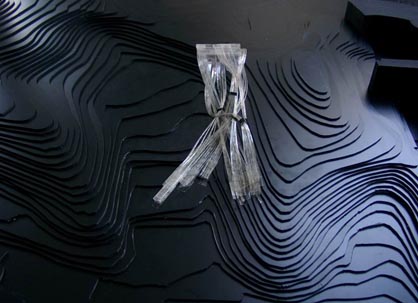 Topographic studies. SPATIAL STUDIES. On another scale the surface is replaced by added strip like elements in order to perform structurally and to generate spatial continuity. This scale translation is based on the morphologic outcome of the analogue performance model and a structural forecasting. it negotiates between the spatial/organizational diagrams and construction techniques. INTEGRATIVE MODELLING |
|||||
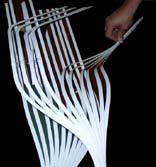 Model evolution. |
SPATIAL
STUDIES. The second generation performance model is limited in its degree
of freedom. The outcomes are rather on the level of spatial architectural
effects than on the level of overall organization. Taking that into
consideration the model is already informed by the organizational diagram.
The deformations are on the level of structural members: shearing,
bundling. |
||||
|
MATERIAL
MODEL. The model is the result of fully integrating the diagrammatic
organizational aspects into to the second generation performance model.
It shows spatial, formal and structural continuity and still has the
potential to be tuned based on its performative capacities. DIGITAL MODEL. The digital is enriched by material performance and effects. Gradually it evolves into a digitally informed reality. The analog generated morphology is enriched by digital techniques. Skin, structure and program are added to the model. The challenge is the multiple crossing of the digital/analogue boundary including the development of various interfaces and translations. Process and production collapse into a continues event. |
 Spatial studies. |
||||
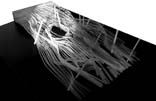 Scale 1:200 Model. |
 Bird view. DESIGN SUMMARY adaptiveARCHIVE is basically organized on two levels and a basement. This layout was chosen in order to have the possibility for expanding the building in height to three stories. The levels are clearly articulated and continuous surfaces over the width of the building. |
||||
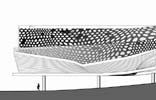 Elevation East. 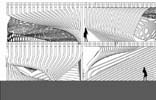 Elevation South. |
 Floor Plan. Towards the north they split in mainly four bundles. The exhibition which starts in the main space in the south is organized along these bundles. In the in-between spaces special programs like the café and the media lab is injected. One elevator next to the lobby connects the exhibition spaces. It is also used for caring goods from the storage space in the basement to the galleries. A network of stairs and ramps enable visitors to take various routes through the adaptiveARCHIVE. |
||||
| EXHIBITION
CONCEPT THE ORGANIZATION OF THE ARCHIVE. The collection of an oeuvre of an outstanding artist tends to become focused on conservational aspects. We see the strong desire of gathering a fantastic retrospective collection of Nam June Paik’s work covering all the very sharply defined articulations of the pieces and periods. But we see also the strong will of the Promoter to create more than a simple collection. The potential given in the brief is to propose an archive that is museum and institution for research at the same time. |
|||||
 Digital model. |
Looking
at the oeuvre and reading the strategies Nam June Paik created and used
during the last 40 years the real strength of the work is not only on
the level of the final product, it is even more the level which is communicated
to us. It is the mode of production, the different strategies he is
using as well as the strong research aspect of his work. From the very
beginning he was investigating heavily in other fields such as music
and electronics and developed new techniques in order to integrate these
fields of investigation into his work. In that sense he is more a scientist
as an artist or better an artist that is behaving as a researcher and
articulating his research through the subject of investigation. This subject changed gradually during the last 30 years going minimal music and taping techniques to TV to different kinds of video to visual synthesizers to laser techniques. The material he is focusing on is always a new leap in technique that is about invading our culture. By studying this subjects and literally manipulating the material he intervenes and shapes the process of cultural adoption. |
||||
| We
can see a desire from the promoter to cover this extraordinary aspect
of Paiks work. This is shown in the brief where it asks for a replica
Paiks studio. Also there is the whish to have students and researchers
coming to the Museum to study over a longer period of time. We appreciate
that and propose an archive organization that enables visitors and researchers
to literally participate in the worlds of Nam June Paik. His work is
often seen as very site specific and unique. Not in a sense it can only
operate at that particular site but that the generic material is carefully
programmed and adopted to the site specifics. We are proposing a build
environment that is characterized by the continuity of a differentiated
spatial organization. Spaces that are articulated and multiple interconnected. |
|||||
| THE
CONSTRUCTION OF THE ARCHIVE. The neutral bundles of strip material are
seen as structural devices and organizational trajectories. The continues
flow of forces is interweaved with continuity of program distribution.
Leaps, flips and twists create a structural as well as programmatic
and spatial event. In general the structure is almost perfectly ordered
at the top end. Every single member of the system is connected to this
major space. The strips start proliferating into smaller enclosures
and surfaces. The display is organized along these strips. A continuous
archive evolves along a series of nodes and links. The main exhibition
space is facing the enormous window to the garden. All other exhibition
facilities such as the special event gallery, the artist requested space
are allocated on the strips. |
|||||
| This
spatial referential system allows various links and connections. It
is articulated in a way that general distinctions of walls, ceiling,
and floor blur into each other. Paik is using these categories in his
artworks almost simultaneously. The proposal invites artist and curators
to make use of the structures surface at almost any point. f-u-r |
|||||
| F-U-R.
adaptiveARCHIVE |
|||||
| Architectural Design Concept developed for the Nam June Paik Museum International competition. | |||||
| f-u-r was founded by Mirco Becker and Oliver Tessmann. The firm works and researches on various intersecting points of architecture and technology. Within this field of interest it developed a blend of projects that covers urban design and architecture as well as digital and physical robots. Some of these projects were successful in competitions as the FEIDAD 2002 others on display at exhibitions like the Latent Utopias in Graz 2003. f-u-r is based in Germany and the UK. | |||||
| > F-U-R | |||||
|
Per
candidare progetti laboratorio
|
|||||